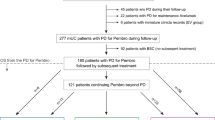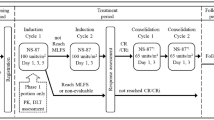Abstract
Purpose This phase II study was designed to determine the overall survival time of adults with supratentorial glioblastoma treated with the immune modulator, polyinosinic-polycytidylic acid stabilized with polylysine and carboxymethylcellulose (poly-ICLC), in combination with and following radiation therapy (RT). Methods and materials This was an open-label, single arm phase II study. Patients were treated with RT in combination with poly-ICLC followed by poly-ICLC as a single agent. Poly-ICLC was initiated 7–28 days after the surgical procedure that established the diagnosis; radiotherapy began within 7 days of the first dose of poly-ICLC and within 35 days of surgical diagnosis. Treatment with poly-ICLC continued following the completion of RT to a maximum of 1 year or until tumor progression. Results 31 patients were enrolled in this study. One patient did not have a Glioblastoma mutiforme and was deemed ineligible. For the 30 eligible patients, time to progression was known for 27 patients and 3 were censored. The estimated 6-month progression-free survival was 30% and the estimated 1-year progression-free survival was 5%. Median time to progression was as 18 weeks. The 1-year survival was 69% and the median survival was 65 weeks. Conclusions The combined therapy was relatively well-tolerated. This study suggests a survival advantage compared to historical studies using RT without chemotherapy but no survival advantage compared to RT with adjuvant nitrosourea or non-temozolomide chemotherapy. Our results suggest that poly-ICLC has activity against glioblastoma and may be worth further study in combination with agents such as temozolomide.
Similar content being viewed by others
References
Stupp R et al (2005) Radiotherapy plus concomitant and adjuvant temozolomide for glioblastoma. N Engl J Med 352(10):987–996. doi:10.1056/NEJMoa043330
Stenning SP, Freedman LS, Bleehen NM (1987) An overview of published results from randomized studies of nitrosoureas in primary high grade malignant glioma. Br J Cancer 56(1):89–90
Stewart LA (2002) Chemotherapy in adult high-grade glioma: a systematic review and meta-analysis of individual patient data from 12 randomised trials. Lancet 359(9311):1011–1018. doi:10.1016/S0140-6736(02)08091-1
Fine HA et al (1993) Meta-analysis of radiation therapy with and without adjuvant chemotherapy for malignant gliomas in adults. Cancer 71(8):2585–2597. doi:10.1002/1097-0142(19930415)71:8<2585::AID-CNCR2820710825>3.0.CO;2-S
Talmadge JE et al (1985) Immunomodulatory effects in mice of polyinosinic-polycytidylic acid complexed with poly-l-lysine and carboxymethylcellulose. Cancer Res 45(3):1058–1065
Levy HB et al (1980) Immune modulating effects of poly ICLC. Ann N Y Acad Sci 350:33–41. doi:10.1111/j.1749-6632.1980.tb20604.x
Hubbell HR, Liu RS, Maxwell BL (1984) Independent sensitivity of human tumor cell lines to interferon and double-stranded RNA. Cancer Res 44(8):3252–3257
Black PL et al (1992) Effect of tumor burden and route of administration on the immunotherapeutic properties of polyinosinic-polycytidylic acid stabilized with poly-l-lysine in carboxymethyl cellulose [Poly(I, C)-LC]. Int J Immunopharmacol 14(8):1341–1353. doi:10.1016/0192-0561(92)90005-6
Dick RS, Hubbell HR (1987) Sensitivities of human glioma cell lines to interferons and double-stranded RNAs individually and in synergistic combinations. J Neurooncol 5(4):331–338. doi:10.1007/BF00148390
Rosenblum MG et al (1990) Growth inhibitory effects of interferon-beta but not interferon-alpha on human glioma cells: correlation of receptor binding, 2′,5′-oligoadenylate synthetase and protein kinase activity. J Interferon Res 10(2):141–151
Strayer DR et al (1987) Growth of astrocytomas in the human tumor clonogenic assay and sensitivity to mismatched dsRNA and interferons. Am J Clin Oncol 10(4):281–284. doi:10.1097/00000421-198708000-00003
Droller MJ (1987) Immunotherapy of metastatic renal cell carcinoma with polyinosinic-polycytidylic acid. J Urol 137(2):202–206
Hawkins MJ, Levin M, Borden EC (1985) An Eastern Cooperative Oncology Group phase I–II pilot study of polyriboinosinic-polyribocytidylic acid poly-l-lysine complex in patients with metastatic malignant melanoma. J Biol Response Mod 4(6):664–668
Krown SE et al (1985) Phase I trials of poly(I, C) complexes in advanced cancer. J Biol Response Mod 4(6):640–649
Nakamura O et al (1982) Phase I-II trials of poly(ICLC) in malignant brain tumor patients. J Interferon Res 2(1):1–4
Rettenmaier MA, Berman ML, DiSaia PJ (1986) Treatment of advanced ovarian cancer with polyinosinic-polycytidylic lysine carboxymethylcellulose (poly ICLC). Gynecol Oncol 24(3):359–361. doi:10.1016/0090-8258(86)90313-6
Theriault RL et al (1986) Evaluation of polyinosinic-polycytidylic and poly-l-lysine in metastatic breast cancer. Cancer Treat Rep 70(11):1341–1342
Talmadge JE et al (1985) Hyporesponsiveness to augmentation of murine natural killer cell activity in different anatomical compartments by multiple injections of various immunomodulators including recombinant interferons and interleukin 2. J Immunol 135(4):2483–2491
Ewel CH et al (1992) Polyinosinic-polycytidylic acid complexed with poly-l-lysine and carboxymethylcellulose in combination with interleukin 2 in patients with cancer: clinical and immunological effects. Cancer Res 52(11):3005–3010
Black KL et al (1992) Inflammatory leukocytes associated with increased immunosuppression by glioblastoma. J Neurosurg 77(1):120–126
Levy HB (1985) Historical overview of the use of polynucleotides in cancer. J Biol Response Mod 4(5):475–480
Levy HB, Levine AS (1981) Antitumor effects of interferon and poly ICLC, and their possible utility as anti-neoplastic agents in man. Tex Rep Biol Med 41:653–662
Matsumoto M, Seya T (2008) TLR3: interferon induction by double-stranded RNA including poly(I:C). Adv Drug Deliv Rev 60(7):805–812
Kim H et al (2008) Double-stranded RNA mediates interferon regulatory factor 3 activation and interleukin-6 production by engaging Toll-like receptor 3 in human brain astrocytes. Immunology 124(4):480–488
Balachandran S, Barber GN (2007) PKR in innate immunity, cancer, and viral oncolysis. Methods Mol Biol 383:277–301. doi:10.1007/978-1-59745-335-6_18
Salazar AM et al (1996) Long-term treatment of malignant gliomas with intramuscularly administered polyinosinic-polycytidylic acid stabilized with polylysine and carboxymethylcellulose: an open pilot study. Neurosurgery 38(6):1096–1103. doi:10.1097/00006123-199606000-00006 discussion 1103–1104
Liu W et al (2007) Tumour suppressor function of RNase l in a mouse model. Eur J Cancer 43(1):202–209. doi:10.1016/j.ejca.2006.08.024
Lee SB et al (1994) Activation of the double-stranded RNA (dsRNA)-activated human protein kinase in vivo in the absence of its dsRNA binding domain. Proc Natl Acad Sci U S A 91(22):10551–10555. doi:10.1073/pnas.91.22.10551
Haines GKIII et al (1998) Interferon-responsive protein kinase (p68) and proliferating cell nuclear antigen are inversely distributed in head and neck squamous cell carcinoma. Tumour Biol 19(1):52–59. doi:10.1159/000029974
Meurs EF et al (1993) Tumor suppressor function of the interferon-induced double-stranded RNA-activated protein kinase. Proc Natl Acad Sci U S A 90(1):232–236. doi:10.1073/pnas.90.1.232
Chacko MS, Ma X, Adamo ML (2002) Double-stranded ribonucleic acid decreases c6 rat glioma cell proliferation in part by activating protein kinase R and decreasing insulin-like growth factor I levels. Endocrinology 143(6):2144–2154. doi:10.1210/en.143.6.2144
Minks MA et al (1979) Structural requirements of double-stranded RNA for the activation of 2′, 5′-oligo(A) polymerase and protein kinase of interferon-treated HeLa cells. J Biol Chem 254(20):10180–10183
Galabru J et al (1989) The binding of double-stranded RNA and adenovirus VAI RNA to the interferon-induced protein kinase. Eur J Biochem 178(3):581–589. doi:10.1111/j.1432-1033.1989.tb14485.x
Hovanessian AG (2007) On the discovery of interferon-inducible, double-stranded RNA activated enzymes: the 2′-5′oligoadenylate synthetases and the protein kinase PKR. Cytokine Growth Factor Rev 18(5–6):351–361
Hovanessian AG (1991) Interferon-induced and double-stranded RNA-activated enzymes: a specific protein kinase and 2′,5′-oligoadenylate synthetases. J Interferon Res 11(4):199–205
Maluish AE et al (1985) Immunomodulatory effects of poly(I, C)-LC in cancer patients. J Biol Response Mod 4(6):656–663
Macdonald DR et al (1990) Response criteria for phase II studies of supratentorial malignant glioma. J Clin Oncol 8(7):1277–1280
Curran WJ Jr et al (1993) Recursive partitioning analysis of prognostic factors in three radiation therapy Oncology Group malignant glioma trials. J Natl Cancer Inst 85(9):704–710. doi:10.1093/jnci/85.9.704
Stupp R et al (2002) Promising survival for patients with newly diagnosed glioblastoma multiforme treated with concomitant radiation plus temozolomide followed by adjuvant temozolomide. J Clin Oncol 20(5):1375–1382. doi:10.1200/JCO.20.5.1375
Chong G, Morse MA (2005) Combining cancer vaccines with chemotherapy. Expert Opin Pharmacother 6(16):2813–2820. doi:10.1517/14656566.6.16.2813
Wheeler CJ et al (2004) Clinical responsiveness of glioblastoma multiforme to chemotherapy after vaccination. Clin Cancer Res 10(16):5316–5326. doi:10.1158/1078-0432.CCR-04-0497
van der Most RG et al (2006) Cranking the immunologic engine with chemotherapy: using context to drive tumor antigen cross-presentation towards useful antitumor immunity. Cancer Res 66(2):601–604. doi:10.1158/0008-5472.CAN-05-2967
Zhu X et al (2007) Toll like receptor-3 ligand poly-ICLC promotes the efficacy of peripheral vaccinations with tumor antigen-derived peptide epitopes in murine CNS tumor models. J Transl Med 5:10. doi:10.1186/1479-5876-5-10
Acknowledgment
We would like to thank Oncovir Inc. for their support of this trial.
Author information
Authors and Affiliations
Corresponding author
Rights and permissions
About this article
Cite this article
Butowski, N., Chang, S.M., Junck, L. et al. A phase II clinical trial of poly-ICLC with radiation for adult patients with newly diagnosed supratentorial glioblastoma: a North American Brain Tumor Consortium (NABTC01-05). J Neurooncol 91, 175–182 (2009). https://doi.org/10.1007/s11060-008-9693-3
Received:
Accepted:
Published:
Issue Date:
DOI: https://doi.org/10.1007/s11060-008-9693-3




